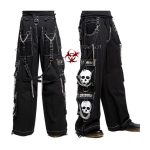The Best 10 Emo Bands

Introduction to Emo Music
Emo music, short for “emotive,” has always been about more than just sound—it’s about feeling. Emerging in the mid-1980s, this genre captivated audiences with its raw emotion, expressive lyrics, and unique fusion of punk roots with melodic storytelling. Over the years, emo has evolved through multiple waves, from its underground beginnings to its mainstream breakthrough, leaving a lasting influence on music and culture. Today, the legacy of emo also lives on through fashion, with fans proudly embracing styles like baggy emo pants to represent their connection to the genre.
The Origins
The story of emo began in Washington, D.C., during the mid-1980s as a subgenre of hardcore punk. Unlike the aggression of punk, early emo bands such as Rites of Spring and Embrace focused on vulnerability, introspection, and deeply personal expression. This emotional honesty became the defining trait of the genre.
In the 1990s, emo branched out with Midwest bands like Cap’n Jazz and American Football, celebrated for their intricate guitar melodies and heartfelt lyrics. Groups like Sunny Day Real Estate and Jawbreaker also played major roles in giving emo a wider audience and evolving its sound.
By the early 2000s, emo hit the mainstream. Bands like Dashboard Confessional, My Chemical Romance, Fall Out Boy, and Paramore introduced emo to millions, blending its emotional depth with pop-punk energy. The influence carried into the 2010s with revival acts like Modern Baseball and The World Is a Beautiful Place & I Am No Longer Afraid to Die, keeping the spirit alive for a new generation.

Top 10 Best Emo Bands
Here’s a list of the most iconic emo bands that helped shape and define the genre:
- My Chemical Romance – Famous for their theatrical performances and the legendary album The Black Parade.
- Fall Out Boy – Brought emo into the mainstream with hits like Sugar, We’re Goin Down.
- Dashboard Confessional – Known for heartfelt acoustic ballads that defined early 2000s emo.
- Taking Back Sunday – Their album Tell All Your Friends remains a cornerstone of the genre.
- Panic! At The Disco – Blended emo with pop sensibilities, producing the hit I Write Sins Not Tragedies.
- The Used – Recognized for their raw energy and powerful lyrics.
- Hawthorne Heights – Gained fame with tracks like Ohio Is for Lovers, a staple in emo culture.
- Brand New – Praised for lyrical depth, with Deja Entendu still beloved by fans.
- Jimmy Eat World – Their album Bleed American introduced emo to a much wider audience.
- Paramore – Started as an emo band with Riot! and evolved into one of the most dynamic acts in alternative music.
Notable Albums Through the Decades
- 1980s (Origins): Rites of Spring (1985), Embrace (1987).
- 1990s (Evolution): Diary by Sunny Day Real Estate (1994), American Football by American Football (1999).
- 2000s (Mainstream Breakthrough): The Places You Have Come to Fear the Most by Dashboard Confessional (2001), Three Cheers for Sweet Revenge by My Chemical Romance (2004).
- 2010s (Revival): Whenever, If Ever by The World Is a Beautiful Place & I Am No Longer Afraid to Die (2013).
The Impact of Emo Bands on Music and Culture
Emo bands not only transformed the sound of alternative music but also shaped an entire subculture. Their influence continues to inspire new generations of artists and fans. Beyond music, emo left its mark on fashion and lifestyle. Fans often express their identity through dark clothing, band tees, and iconic styles like baggy emo pants, which became synonymous with the emo aesthetic.
Conclusion
The top 10 emo bands listed here have all played a crucial role in shaping the genre’s past, present, and future. From emotional storytelling to iconic fashion statements, emo remains more than just music—it’s a cultural movement. Whether you’re reliving the early 2000s or exploring the revival sounds of today, the influence of emo will always live on in both the music and the style that fans proudly carry forward.
Recent Posts
Categories
Related Articles
Ultimate Style Guide: Emo & Pop Punk Fashion with Black Emo Pants and Tripp Pants
Emo and Pop Punk aren’t just music genres—they’re entire lifestyles. From dark,...
ByemopantsOctober 6, 2025The Famous 2000s Emo Fashion — Is It Back with Emo Pants?
The 2000s were iconic for many reasons, but nothing defined that era...
ByemopantsOctober 6, 2025What It Really Means to Be Emo: Style, Culture & the Power of Emo Pants
Emo isn’t just a genre of music—it’s a way of life, a...
ByemopantsOctober 6, 2025Free Music Festivals in California & The Perfect Vibe with Emo Pants
California is more than beaches, palm trees, and Hollywood stars—it’s also home...
ByemopantsOctober 6, 2025















Leave a comment